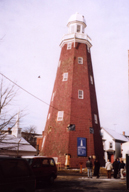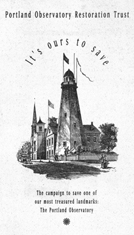Portland Observatory to Greet the Millenieum with
a Million Dollar Facelift
Restoration of the 1807 Portland landmark is on schedule.
Grand reopening planned for June of 2000.
by Jack Reynolds
 Portland
Observatory, the city's curious relic of early maritime communications,
is nearing the end of its million dollar restoration. Wooden
beams have been replaced and the beetles that have been nibbling at them
are no more. Most of the outside work is done, including a
coat of authentic dark red exterior paint recreated from a shingle recovered
during a 1904 restoration. The lantern housing is back on top and
another couple of months will see the interior of the main tower returned
to its 19th century splendor. A June, 2000 grand reopening ceremony
will kick off the venerable towers third century of service.
Portland
Observatory, the city's curious relic of early maritime communications,
is nearing the end of its million dollar restoration. Wooden
beams have been replaced and the beetles that have been nibbling at them
are no more. Most of the outside work is done, including a
coat of authentic dark red exterior paint recreated from a shingle recovered
during a 1904 restoration. The lantern housing is back on top and
another couple of months will see the interior of the main tower returned
to its 19th century splendor. A June, 2000 grand reopening ceremony
will kick off the venerable towers third century of service.
Looming up from the summit of Munjoy Hill, the Observatory is an eye
catcher for first time Portland visitors. Many of them wonder about
the function of the brown shingled tower that looks a bit like a windmill
shorn of its vanes. Those whose curiosity propels them up Munjoy
Hill for a closer look find out that for 117 years it served as Portland's
window on the sea.
They learn that the old Observatory's years of service spanned a revolution
in marine communications that ushered in today's  routine
electronic voice messaging. Nowadays, the skipper of a Portland
bound supertanker picks up a navigation bridge radiophone to let the home
office know that he is on the way. Two centuries ago on the
heaving open deck of a Portland bound sailing ship things weren't
so simple. Ten miles from the city, its skipper was as far
out of touch with his home office as when he departed the West Indies a
month ago.
routine
electronic voice messaging. Nowadays, the skipper of a Portland
bound supertanker picks up a navigation bridge radiophone to let the home
office know that he is on the way. Two centuries ago on the
heaving open deck of a Portland bound sailing ship things weren't
so simple. Ten miles from the city, its skipper was as far
out of touch with his home office as when he departed the West Indies a
month ago.
At this point, Captain Lemuel Moody, an enterprising local skipper,
figured that an early warning system for ships hull down on the horizon
could help smooth out Portland port operations while turning a tidy profit
for investors. His proposal to erect a 65 foot octagonal
wooden tower at the crest of the city's highest hill, equipped with a powerful
telescope and a set of signal flags also looked like good business to ninety-nine
prosperous fellow townsmen. They formed a corporation and pumped
capital into Moody's unique signal tower. Until
radios and phones came on line a century later, the Observatory served
as Portland's sole link with ships off shore.
 For
the next 40 years, perched in his tower 200 feet above sea level,
Moody swivelled its ceiling mounted telescope to cover all seaward
approaches to Portland. When a ship was spotted, a glance at the
compass rose painted on the observatory ceiling indicated its bearing.
Moody's educated eye calculated its range in sea miles. Once satisfied
of the vessel's identity and position, he climbed out onto the narrow observatory
open deck to encode his information in a colorful display of wind whipped
flags.
For
the next 40 years, perched in his tower 200 feet above sea level,
Moody swivelled its ceiling mounted telescope to cover all seaward
approaches to Portland. When a ship was spotted, a glance at the
compass rose painted on the observatory ceiling indicated its bearing.
Moody's educated eye calculated its range in sea miles. Once satisfied
of the vessel's identity and position, he climbed out onto the narrow observatory
open deck to encode his information in a colorful display of wind whipped
flags.
Meanwhile, a mile away down on the Portland wharves, it was payoff time
for the subscribing ship owner who caught sight of his house flag fluttering
at the top of the Observatory staff. Orders flew out to reserve dock
space and hire stevedores.
And if the incoming cargo happened to be in short supply in the city,
his $25 annual Observatory subscription paid off in a market cornering
end run around the competition.
Between notices of arrivals to paying clients, Moody kept a weather
eye for shipwrecks. A special set of emergency flags was ready to fly when
a distressed ship showed up field of his powerful telescope. He even managed
to work in some pre-tv age prime time newscasting. His biggest scoop,
a nearby War of 1812 battle between the British brig, Boxer, and the American
brig, Enterprise, provoked a flag display that was unmistakable to
Portlanders. An American ensign over a British ensign signaled that
the American warship was headed in with a captured British prize.
Moody was Portland's last eighteenth century jack of all disciplines
renaissance men. When he wasn't on his observatory platform
spotting ships, he busied himself as the city's unofficial weatherman
and Casco Bay cartographer. A 1807 Portland newspaper ad announced
that he was teaching a class in navigation at the Observatory.
Meanwhile, the money making potential of his hilltop Observatory site
didn't escape Moody's keen business acumen. While the
last shingles were being tacked onto the new Observatory tower, he was
busy laying out an amusement park that included a bowling alley, a banquet
hall, a dance hall and a playing field. Paying guests were
treated to a climb up the steep tower staircase to the observation deck.
By the turn of the 20th century, however, time was starting to
run out for the Portland Observatory. Radios and telephones rendered
its visual communications system obsolete. Early in the
century, houses crept up the side of Munjoy hill masking the towers line
of sight to the Portland wharves. Later, the Portland Fire Department's
Munjoy Hill Station over spread the amusement park site. The ship reporting
business fell steadily until 1924 when the last flag signal was hauled
down. In 1937 the Observatory passed out of the Moody family's hands.
Finally, in 1995 the weakened tower was declared off limits to visitors.
Despite its declining fortunes, Moody's tower remains a survivor.
It missed the 1700s by a scant seven years. It outlived
the next two centuries of Maine northeasters and narrowly escaped a disastrous
1867 city-wide conflagration. When Portland Observatory Restoration
Trust finishes up the old survivor's latest repair job a few days shy of
the 21st century, it looks good for another 200 years of service as Portland's
window on Casco Bay as well as a retrospective window on Portland's own
colorful maritime past.
Back to Page 1
 routine
electronic voice messaging. Nowadays, the skipper of a Portland
bound supertanker picks up a navigation bridge radiophone to let the home
office know that he is on the way. Two centuries ago on the
heaving open deck of a Portland bound sailing ship things weren't
so simple. Ten miles from the city, its skipper was as far
out of touch with his home office as when he departed the West Indies a
month ago.
routine
electronic voice messaging. Nowadays, the skipper of a Portland
bound supertanker picks up a navigation bridge radiophone to let the home
office know that he is on the way. Two centuries ago on the
heaving open deck of a Portland bound sailing ship things weren't
so simple. Ten miles from the city, its skipper was as far
out of touch with his home office as when he departed the West Indies a
month ago.
 Portland
Observatory, the city's curious relic of early maritime communications,
is nearing the end of its million dollar restoration. Wooden
beams have been replaced and the beetles that have been nibbling at them
are no more. Most of the outside work is done, including a
coat of authentic dark red exterior paint recreated from a shingle recovered
during a 1904 restoration. The lantern housing is back on top and
another couple of months will see the interior of the main tower returned
to its 19th century splendor. A June, 2000 grand reopening ceremony
will kick off the venerable towers third century of service.
Portland
Observatory, the city's curious relic of early maritime communications,
is nearing the end of its million dollar restoration. Wooden
beams have been replaced and the beetles that have been nibbling at them
are no more. Most of the outside work is done, including a
coat of authentic dark red exterior paint recreated from a shingle recovered
during a 1904 restoration. The lantern housing is back on top and
another couple of months will see the interior of the main tower returned
to its 19th century splendor. A June, 2000 grand reopening ceremony
will kick off the venerable towers third century of service.
 For
the next 40 years, perched in his tower 200 feet above sea level,
Moody swivelled its ceiling mounted telescope to cover all seaward
approaches to Portland. When a ship was spotted, a glance at the
compass rose painted on the observatory ceiling indicated its bearing.
Moody's educated eye calculated its range in sea miles. Once satisfied
of the vessel's identity and position, he climbed out onto the narrow observatory
open deck to encode his information in a colorful display of wind whipped
flags.
For
the next 40 years, perched in his tower 200 feet above sea level,
Moody swivelled its ceiling mounted telescope to cover all seaward
approaches to Portland. When a ship was spotted, a glance at the
compass rose painted on the observatory ceiling indicated its bearing.
Moody's educated eye calculated its range in sea miles. Once satisfied
of the vessel's identity and position, he climbed out onto the narrow observatory
open deck to encode his information in a colorful display of wind whipped
flags.